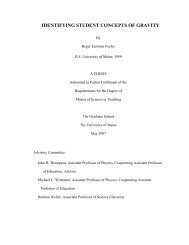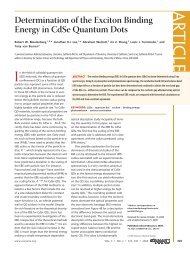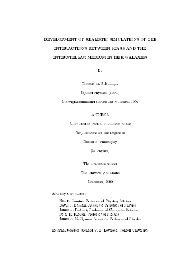Evidence of a ZnCr2Se4 Spinel Inclusion at the Core of a Cr-Doped ...
Evidence of a ZnCr2Se4 Spinel Inclusion at the Core of a Cr-Doped ...
Evidence of a ZnCr2Se4 Spinel Inclusion at the Core of a Cr-Doped ...
You also want an ePaper? Increase the reach of your titles
YUMPU automatically turns print PDFs into web optimized ePapers that Google loves.
Journal <strong>of</strong> <strong>the</strong> American Chemical Society<br />
Article<br />
Figure 4. (A) Frequency-dependent EPR measurements <strong>at</strong> 10 K for 2.5% Zn 1−x <strong>Cr</strong> x Se QD. (B) Frequency-dependent on EPR central resonance field<br />
<strong>of</strong> 2.5% Zn 1−x <strong>Cr</strong> x Se QD. The slope yields a g-value <strong>of</strong> 1.9808.<br />
resonance over all frequencies is consistent with a <strong>Cr</strong>(III) ion<br />
(d 3 , S = 3/2) since <strong>the</strong> zero-field splitting for <strong>Cr</strong>(III) is typically<br />
small. 50<br />
An accur<strong>at</strong>e value <strong>of</strong> <strong>the</strong> Landég-value for <strong>the</strong> <strong>Cr</strong>(III) center<br />
in <strong>the</strong> Zn 1−x <strong>Cr</strong> x Se QD can be obtained by plotting <strong>the</strong><br />
frequency dependence <strong>of</strong> <strong>the</strong> center field (Figure 4B). The plot<br />
yields a g-value <strong>of</strong> 1.9808 consistent with <strong>the</strong> prediction for a<br />
<strong>Cr</strong>(III) ion coordin<strong>at</strong>ed by six Se ions. 51,50 The devi<strong>at</strong>ion <strong>of</strong> <strong>the</strong><br />
g-value from <strong>the</strong> spin only value <strong>of</strong> g e = 2.0023 is caused by a<br />
contribution from triplet T 2 to <strong>the</strong> orbital moment <strong>of</strong> <strong>the</strong><br />
ground st<strong>at</strong>e. The observed EPR p<strong>at</strong>tern and g-value are not<br />
consistent with assignment <strong>of</strong> <strong>Cr</strong>(II) or <strong>Cr</strong>(I). 23,50 Experimentally<br />
observed g-values are 1.9985 for <strong>Cr</strong>(II) 52 and 2.0018<br />
for <strong>Cr</strong>(I). 53 Fur<strong>the</strong>rmore, <strong>the</strong> zero-field splitting <strong>of</strong> <strong>Cr</strong>(II) ion<br />
(d 4 , S = 2) is usually larger than 2 cm −1 with a neg<strong>at</strong>ive sign,<br />
which would result in <strong>the</strong> appearance <strong>of</strong> multiple transitions in<br />
<strong>the</strong> EPR spectra (M s : −2 → −1, −1 → 0, 0 → +1, and +1 →<br />
+2 transitions), 23,50 which are not observed in Figure 4.<br />
Zn<strong>Cr</strong> 2 Se 4 <strong>Spinel</strong> <strong>Inclusion</strong> form<strong>at</strong>ion. Since <strong>the</strong> structural<br />
d<strong>at</strong>a from TEM and pXRD are in good agreement, <strong>the</strong><br />
results strongly imply a high degree <strong>of</strong> crystallinity exists for <strong>the</strong><br />
<strong>Cr</strong>ZnSe QD, which in effect implies th<strong>at</strong> <strong>the</strong> <strong>Cr</strong>(III) ions<br />
incorpor<strong>at</strong>e with minimal l<strong>at</strong>tice distortion. The spectroscopy<br />
results confirm <strong>the</strong> <strong>Cr</strong> ion is incorpor<strong>at</strong>ed into <strong>the</strong> ZnSe l<strong>at</strong>tice<br />
as a <strong>Cr</strong>(III) ion occurring <strong>at</strong> a tetragonally distorted sixcoordin<strong>at</strong>e<br />
site in an o<strong>the</strong>rwise sphalerite l<strong>at</strong>tice for <strong>the</strong> Zn and<br />
Se subl<strong>at</strong>tices. Addition <strong>of</strong> one <strong>Cr</strong>(III) must induce removal <strong>of</strong><br />
one and a half Zn(II) centers to balance <strong>the</strong> QD charge, if <strong>the</strong><br />
<strong>Cr</strong>(III) ion incorpor<strong>at</strong>es into <strong>the</strong> core <strong>of</strong> <strong>the</strong> QD. More likely to<br />
be stoichiometrically relevant, <strong>the</strong> <strong>Cr</strong>(III) ion incorpor<strong>at</strong>es as a<br />
pair <strong>of</strong> O h coordin<strong>at</strong>ed <strong>Cr</strong> ions sharing an edge by removal <strong>of</strong><br />
three Zn ions. Such an arrangement is supported by <strong>the</strong><br />
XANES d<strong>at</strong>a. Charge compens<strong>at</strong>ion driven vacancy form<strong>at</strong>ion<br />
is a well-known phenomenon for metal chalcogenides, and one<br />
<strong>of</strong> <strong>the</strong> major reason p or n doping <strong>of</strong> <strong>the</strong> II−VI class is difficult<br />
to achieve. 54<br />
The observ<strong>at</strong>ion <strong>of</strong> <strong>Cr</strong>(III) ion incorpor<strong>at</strong>ion r<strong>at</strong>her than as<br />
<strong>Cr</strong>(II) is interesting and is believed to reflect <strong>the</strong>rmodynamic<br />
forces. <strong>Cr</strong>(III) is a d 3 metal ion which favors O h coordin<strong>at</strong>ion.<br />
The d 3 configur<strong>at</strong>ion has a lowest-lying half-filled t 2g orbital,<br />
inducing gre<strong>at</strong>er <strong>the</strong>rmodynamic stability for <strong>the</strong> <strong>Cr</strong>(III) center.<br />
In fact, <strong>of</strong> <strong>the</strong> AB 2 X 4 structures th<strong>at</strong> are known for <strong>Cr</strong>(III) ion<br />
incorpor<strong>at</strong>ion into II−VI semiconductor, <strong>Cr</strong>(III) shows <strong>the</strong><br />
gre<strong>at</strong>est <strong>the</strong>rmodynamic potential for occup<strong>at</strong>ion <strong>of</strong> O h sites. 27<br />
Fur<strong>the</strong>r stabiliz<strong>at</strong>ion <strong>of</strong> <strong>the</strong> center is achieved by <strong>the</strong> favorable<br />
ionic radius <strong>of</strong> <strong>Cr</strong>(III) (0.755 Å) which can fit into O h site<br />
formed by Zn ion vacancy, whereas <strong>Cr</strong>(II) has a much larger<br />
radius <strong>of</strong> 0.94 Å. While it might be anticip<strong>at</strong>ed th<strong>at</strong> <strong>the</strong><br />
form<strong>at</strong>ion <strong>of</strong> <strong>Cr</strong>(III) is surprising, due to better charge balance<br />
for <strong>Cr</strong>(II), observ<strong>at</strong>ion <strong>of</strong> a change in oxid<strong>at</strong>ion st<strong>at</strong>e for a<br />
doped metal ion is observed reflecting <strong>the</strong> form<strong>at</strong>ion <strong>of</strong> a<br />
<strong>the</strong>rmodynamically more stable oxid<strong>at</strong>ion for Cu(I):CdSe and<br />
Eu(III):CdSe QDs. 19,20<br />
While <strong>the</strong> oxid<strong>at</strong>ion st<strong>at</strong>e <strong>of</strong> <strong>the</strong> <strong>Cr</strong> ion can be r<strong>at</strong>ionalized,<br />
<strong>the</strong> loc<strong>at</strong>ion <strong>of</strong> <strong>the</strong> <strong>Cr</strong>(III) ions and whe<strong>the</strong>r it is best<br />
represented as a stochastically distributed defect in <strong>the</strong> l<strong>at</strong>tice,<br />
isol<strong>at</strong>ed <strong>at</strong> <strong>the</strong> QD surface, or as a cluster within <strong>the</strong> QD core<br />
can only be specul<strong>at</strong>ed. If we assume a Poisson distribution <strong>of</strong><br />
<strong>the</strong> <strong>Cr</strong>(III) ions, it is anticip<strong>at</strong>ed only localized single <strong>Cr</strong>(III)<br />
sites will form within <strong>the</strong> l<strong>at</strong>tice with a 73% probability, while<br />
pair form<strong>at</strong>ion would be 19%, and a larger cluster would occur<br />
<strong>at</strong> 8%. 3 If we assume a cluster model, <strong>at</strong> 2.5% <strong>Cr</strong>(III)<br />
incorpor<strong>at</strong>ion into <strong>the</strong> 2.8 nm ZnSe QD (∼300 Zn ions) would<br />
gener<strong>at</strong>e two n = 2 tetrameric clusters (or four n = 1 dimeric<br />
clusters) from <strong>the</strong> ∼8 available <strong>Cr</strong>(III) ions substituted for 12<br />
Zn ions on average. Likewise, for a 0.4% <strong>Cr</strong>(III) doping level,<br />
this transl<strong>at</strong>es to only two <strong>Cr</strong>(III) centers per QD and could<br />
only produce <strong>at</strong> most a single pair <strong>of</strong> ions. The actual numbers<br />
<strong>of</strong> <strong>Cr</strong> ions will be represented as a stochastic distribution across<br />
<strong>the</strong> QDs due to <strong>the</strong> expected distribution in doping levels as <strong>the</strong><br />
QD grows.<br />
Incorpor<strong>at</strong>ion <strong>of</strong> an isol<strong>at</strong>ed stochastic defect ion is expected<br />
to exhibit Vegard law behavior, 7 while a clustered ion or surface<br />
localized <strong>Cr</strong>(III) center is not expected to exhibit Vegard law<br />
behavior. Since XRD methods must obey Bragg’s law over<br />
several l<strong>at</strong>tice planes, <strong>the</strong> lack <strong>of</strong> a shift in <strong>the</strong> pXRD for <strong>the</strong><br />
Zn<strong>Cr</strong>Se QDs as a function <strong>of</strong> <strong>the</strong> doping concentr<strong>at</strong>ion<br />
suggests th<strong>at</strong> <strong>the</strong> ions are not well represented by a<br />
stochastically distributed ion producing an average l<strong>at</strong>tice<br />
distortion. The altern<strong>at</strong>ive ion clustering model suggested by<br />
<strong>the</strong> XANES would be consistent with <strong>the</strong> lack <strong>of</strong> shift in <strong>the</strong><br />
pXRD d<strong>at</strong>a.<br />
The incorpor<strong>at</strong>ion <strong>of</strong> <strong>Cr</strong>(III) ions as a pair into <strong>the</strong> ZnSe<br />
l<strong>at</strong>tice forms <strong>the</strong> initial cell <strong>of</strong> a spinel phase <strong>of</strong> <strong>the</strong> form A<strong>Cr</strong> 2 X 4<br />
(A = Cd, Zn; X = S, Se). 27 Such a structure is supported by <strong>the</strong><br />
only available spinel phase diagram (Cd<strong>Cr</strong> 2 Se 4 ) where a solid<br />
solution is formed for Cd to <strong>Cr</strong> r<strong>at</strong>ios below 64%. In this range<br />
it is observed th<strong>at</strong> a peritectoid reaction leads to <strong>the</strong> Cd<strong>Cr</strong> 2 Se 4<br />
spinel precipit<strong>at</strong>ing out <strong>of</strong> <strong>the</strong> metal chalcogenide crystal below<br />
885 °C due to low solubility in <strong>the</strong> phase. 29 Inspection <strong>of</strong> <strong>the</strong><br />
5581<br />
dx.doi.org/10.1021/ja210285p | J. Am. Chem. Soc. 2012, 134, 5577−5585






